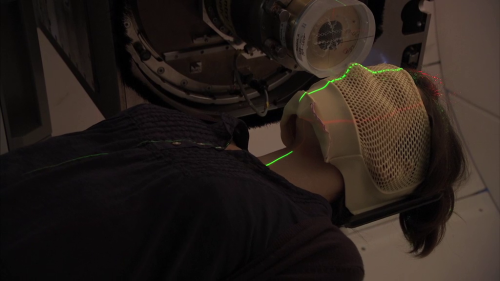Tag archives: medical physics
Adaptive optics in biology
By Matin Durrani
For centuries, astronomers looking up at the heavens through a telescope had a problem on their hands – the quality of their images depended on the strength and direction of the wind in the air. Trouble is, the Earth’s atmosphere isn’t uniform because its density – and thus its refractive index – varies from point to point as the wind blows. Result: distorted images.
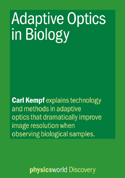
Carl Kempf’s new short-form Physics World Discovery ebook is free to read
In 1953, however, astronomer Horace Babcock proposed a clever solution, which was to bounce incoming light off a device that can rapidly correct for changes in optical path-length, which flattens the wave-front and so counteracts the effects of aberration. Any remaining wave-front errors are measured after the correction, before a feedback control loop uses the measurement to continuously adjust the corrections applied to the wave-front.
That was the principle behind “adaptive-optics” technology, which has since gone on to become a routine and invaluable part of astronomy. Turns out, however, that the same principles can be used in microscopy too, leading to many applications of adaptive optics in medicine and biology too, as I’ve discovered by commissioning and editing a new short-form Physics World Discovery ebook by Carl Kempf.
Kempf is a senior systems engineer at the California-based firm Iris AO, Inc, which is heavily into adaptive-optics technology, having worked on sensing, actuation, and control systems for high-precision devices for more than 30 years. I’m pleased to say that Kempf’s short ebook, Adaptive Optics in Biology, is now available for you to read free in EPUB, Kindle and PDF format via this link.
To give you some more idea of what the book is about and his career to date, I put some questions to Kempf, which you can read below. Don’t forget either that there are plenty of other books in the Physics World Discovery series, ranging from multimessenger astronomy to quantitative finance.
View all posts by this author | View this author's profile
Celebrating the International Day of Medical Physics
By James Dacey
Today is the International Day of Medical Physics (IDMP), as events around the world raise awareness of the vital work carried out by the profession. Now in its fifth year, the 2017 initiative focuses on issues affecting female patients and the safety of women working in medical physics. The theme was chosen to mark the 150th anniversary of the birth of Marie Curie whose pioneering work on radioactivity still underpins various medical treatments and diagnostics – particularly for cancer patients.
“It is well known that medical physicists have developed imaging and radiotherapy methods that have increased women’s length of life and have improved quality of life,” says John Damilakis of the International Organization of Medical Physics (IOMP), which co-ordinates the annual event. “For example, X-ray mammography for the early diagnosis of breast cancer, dual-energy X-ray absorptiometry for the diagnosis of osteoporosis and brachytherapy methods for gynecologic cancer.”
View all posts by this author | View this author's profile
Proton therapy: the benefits and the challenges
Proton therapy is an increasingly popular treatment technique that uses beams of protons to accurately target and destroy cancerous tumours. A new Physics World Discovery ebook, Proton Beam Therapy, takes a close look at the physics of this cancer treatment, its benefits and the challenges associated with bringing this approach into the clinical mainstream.
The ebook is written by Harald Paganetti, director of physics research at Massachusetts General Hospital and professor of radiation oncology at Harvard Medical School. He is a pioneer in advanced Monte Carlo dose calculations for proton therapy, and is considered the world expert on the relative biological effectiveness of proton beams.
In the last few decades, proton therapy has transitioned from research laboratories into the clinical setting – making this publication particularly timely. There are currently around 60 proton therapy facilities worldwide, and this number is increasing rapidly. “Proton therapy is becoming a standard treatment option but there are still many challenges in terms of the physics, biology and clinical use of protons, which are summarized in this ebook,” Paganetti explains.
View all posts by this author | View this author's profile
Testing the brain’s “physics engine”, lawnmower aurora alert and more
By Hamish Johnston and Tushna Commissariat
You may not know it, but apparently you have a dedicated region in your brain that is your “physics engine”. At least that is what cognitive researchers from Johns Hopkins University are suggesting after they have pinpointed a specific region of the human brain that intuitively understands physics – at least when it comes to predicting how objects behave in the real world. According to the team, the engine is kick-started when we observe physical events as they happen and is “among the most important aspects of cognition for survival”. Surprisingly, the region is not located in the brain’s vision centre, but is actually the same area we tap into while making plans of any type. In the video above, the team has created a little game for you to test your engine’s horsepower – go ahead and tell us how you did.
View all posts by this author | View this author's profile
Celtic god of thunder gets an attosecond makeover
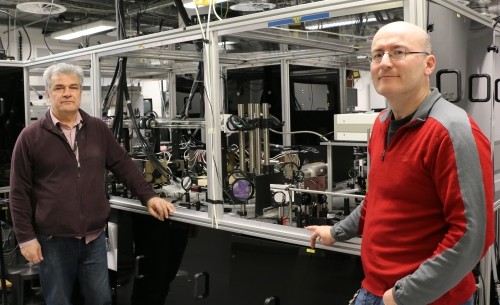
Gods of thunder: Gagik Nersisyan (left) and Matt Zepf at the TARANIS laser facility.
By Hamish Johnston
I recently had the pleasure of visiting Matt Zepf, who directs the Centre for Plasma Physics at Queen’s University Belfast. Zepf and his colleague Gagik Nersisyan showed me around the TARANIS laser facility, which creates extremely bright flashes of light just like its namesake the Celtic god of thunder.
TARANIS is about to upgraded to TARANIS-X, which will deliver ultrashort pulses of extreme ultraviolet light (EUV) that are just a few attoseconds (10–18 s) in duration. Each attosecond pulse will deliver more than 10 µJ, which Zepf says will make TARANIS-X the most powerful laser of its kind by a comfortable margin.
View all posts by this author | View this author's profile
Horsing around with some innovative physics

(Left to right) Physicists Giedre Podolyak, Steve Roberts and Snezhana Chater of Hallmarq Veterinary Imaging celebrate their success in the IOP Innovation Awards.
By Margaret Harris
Imagine you’re a veterinarian and a trainer asks you to take a look at a horse. The animal, a champion showjumper, is limping slightly but there is no obvious injury. Exploratory surgery would probably do more harm than good, and the alternative – magnetic resonance imaging (MRI) – isn’t risk-free either. You’d need to put the horse under a general anaesthetic, and you know horses don’t react well to that; in fact, around 0.5% suffer serious injuries while coming round afterwards. And that’s assuming you can even find a scanner big enough to fit a horse. What do you do?
This might sound like a fairly niche dilemma, but for Hallmarq Veterinary Imaging it has become the basis for a thriving business – a business, moreover, that has just won an IOP Innovation Award for the successful application of physics in a commercial product.
At the awards ceremony – which took place last night in the Palace of Westminster, London, just down the hall from the House of Commons chamber – I caught up with Hallmarq’s operations and technical director, Steve Roberts. After sketching out the scenario of the veterinarian and the injured horse, Roberts, a physicist, explained that Hallmarq’s MRI scanner fits around the horse’s leg. This means that equine patients can simply be led into it, sedated but conscious. Sophisticated error-correction and image-processing software helps the scanner compensate for the horse’s movement, and in 15 years of operation, Roberts estimates that veterinarians have used Hallmarq’s machines to scan more than 60,000 horses.
Lament for ‘the reactor that can do everything’
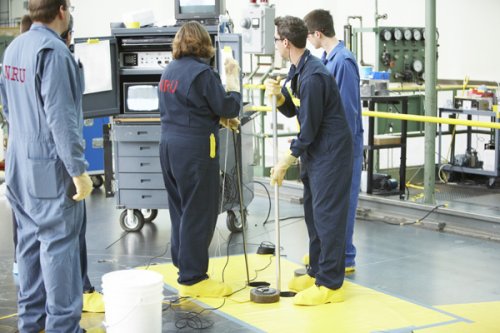
Inside the NRU. (Courtesy: Atomic Energy of Canada)
By Hamish Johnston at the CAP Congress in Edmonton
In 1957 Atomic Energy of Canada built “a reactor that can do everything” at Chalk River, Ontario. Dubbed the National Reactor Universal – or NRU – that facility will shut down for good in 2018 and Canada’s neutron-science community is now pondering its future.
In the short term, physicists will have to travel abroad to use neutron sources, such as those at Oak Ridge in the US and Grenoble in France. The challenge during this 10–15 year period will be to keep the research community together and make sure that vital skills and expertise built up over decades at the NRU will be retained. In the longer term, there are calls for Canada to build a new neutron facility, but it is by no means clear whether that will happen.
‘Physics across Canada’ tour kicks off in Edmonton
By Hamish Johnston
Greetings from Edmonton on the western edge of the Canadian prairies, where I am starting my “Physics across Canada” tour. The nation’s physicists are gathering here for the annual Canadian Association of Physicists Congress at the University of Alberta.
The congress opens today with a session that promises to be out of this world. Exoplanet expert Sara Seager of the Massachusetts Institute of Technology is talking about the search for habitable worlds beyond our blue planet. I am really keen to learn more about the latest techniques for studying the atmospheres of exoplanets and I plan to record an interview about that very subject later this week.
View all posts by this author | View this author's profile
Physics World 2015 Focus on Medical Imaging now live
By Tami Freeman
Medical imaging is a multidisciplinary science encompassing a wide range of powerful techniques with applications in both patient care and fundamental biological studies. In this latest Physics World focus issue, we examine how imaging technologies such as X-ray computed tomography (CT), magnetic resonance imaging and other nuclear, ultrasound and optical imaging techniques have evolved in recent years. We also take a look at what improvements can be expected in the future.
Created in collaboration with our sister website medicalphysicsweb, the new focus issue on medical imaging can be accessed free of charge in digital-magazine format.
View all posts by this author | View this author's profile
A sight for blind eyes
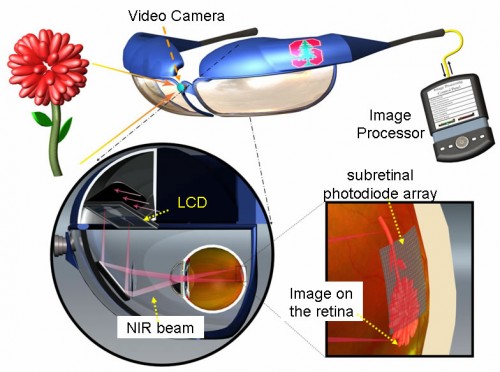
A schematic of the prosthetic vision system developed by Daniel Palanker. (Courtesy: Daniel Palanker)
By Margaret Harris at the AAAS meeting in San Jose
“Restoration of sight to the blind” is a brave claim, one with an almost Biblical ring to it. For Daniel Palanker, though, it is beginning to look as if it is an achievable goal. A medical physicist at the University of Stanford, Palanker has developed a prosthetic vision system that replaces damaged photoreceptors in the retina with an array of tiny photodiodes. When infrared images are projected onto this array, the photodiodes convert the light pulses into electrical signals, which are then picked up by the neurons behind the retina and transmitted to the brain. The result is an artificially induced visual response that, while not as good as normal vision, could nevertheless provide “highly functional restoration of sight” to people with conditions such as retinitis pigmentosa or age-related macular degeneration (AMD).
